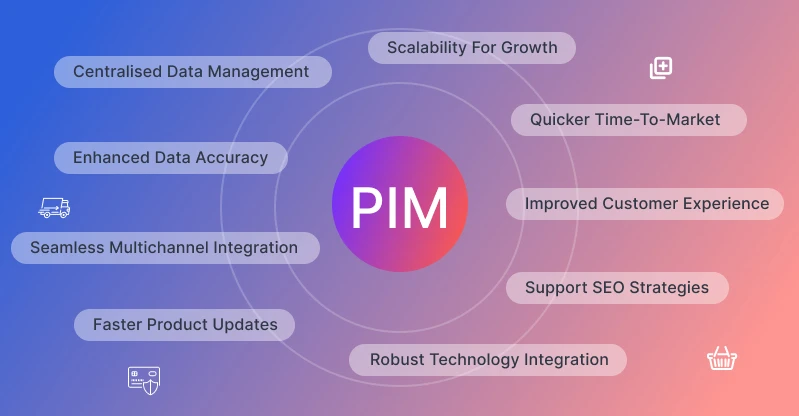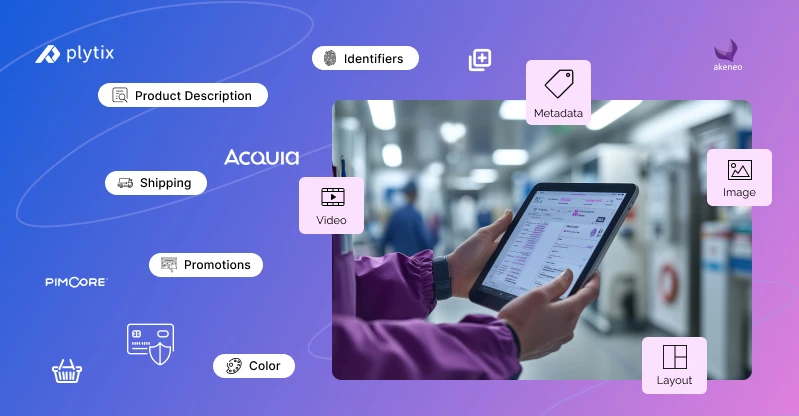10 Powerful Ways a PIM System Can Transform Your eCommerce Business

Handling and maintaining various products and services manually in eCommerce has been complicated. As the company grows, the volume of data, product complexity, need for updates, and regular checkups have sometimes been overwhelming. Manual handling can lead to dissatisfaction, lack of accuracy, and many errors, which in turn lead to a poor customer experience.
A Product Information Management System (PIMS) has been developed to overcome this. According to the expected projections, the revenue of the global product information management market will increase at a compound annual growth rate of 21.1%, from $4.47 billion in 2024 to $20.66 billion by 2032.
A Product Information Management (PIM) system is a centralised platform that helps companies collect, organise, and display product data across different channels. This blog will discuss how the PIM system for eCommerce businesses can bring a digital transformation in the Australia.
10 PIM Features to Transform eCommerce
Centralised Data Management
The centralised system manages data to ensure consistency and accuracy. The Product Information Management System (PIMS) integrates product data and descriptions, reducing duplication and simplifying data access. This encourages better teamwork and confidence in managing product information effectively.
Enhanced Data Accuracy
Manually managing data can be complicated sometimes, as recording, storing, or handling the data as humans can be disturbing. The chances of inefficiency, duplication and human error would increase as it needed the unified product data.
The PIMS has automated the process of managing data and its inconsistencies. It reduces the possibility of errors such as incorrect pricing, missing product descriptions, and inaccurate photos that occur when data is manually entered.
Seamless Multichannel Integration
Multichannel Integration implies synchronisation from a single source to all the channels. The PIM system has made it easy to process and advertise the same information about the product on all the channels or software, such as eCommerce websites, an online marketplace (Amazon or eBay), social media platforms, or stored databases.
This seamless integration ensures the customer gets accurate information on each platform, enhancing engagement and clarifying confusion.
This smooth multichannel integration guarantees reliability and consistency across every point of interaction for increasing efficiency, time-to-market, and the customer experience.

Faster Product Updates
Updation is necessary, as it would be helpful for consumers to stay connected with the offers, discounts and new product launches. In this case, updating product information across all platforms has been necessary to speed up to maintain the business growth significantly. It boosts the workflow drastically, updates on time, reduces inconsistency and encourages teams to concentrate on more significant tasks.
It will help you reduce the need to manually enter new product updates, specifications, or promotions into each sales channel, which can be time-consuming and error-prone. Real-time product synchronisation enables businesses to respond quickly to market changes, expand marketing campaigns, and launch new products, improving their competitiveness and agility in the fast-paced eCommerce environment.
Robust Technology Integration
As the digital world has grown drastically, integration with AI and advanced technologies can have positive impacts on business growth. Businesses can utilise a PIM system that integrates with AI and modern technology to analyse client behaviour, forecast trends, and customise product recommendations.
Remarkably, 92% of businesses have already adopted AI-powered personalisation to boost expansion. Modern AI technology promotes managing the data and streamlining the workflow.
It also supports recommending related images for marketing purposes, generating engaging content and product descriptions, and providing high-value initiatives. Artificial intelligence (AI) can reduce human labour by automating processes like product classification, feature suggestion, and international description translation.
Support SEO Strategies
eCommerce owners prioritise supporting SEO strategies to grow their businesses significantly. Companies can optimise SEO by managing key SEO components such as product titles, descriptions, meta tags, and keywords in a unified system. This is also true for the PIM system, where it is critical to ensure that product information is optimised and consistent across all platforms.
Businesses consistently use PIM to boost their product page search engine rankings. This increases the likelihood of potential buyers discovering their products via search engines, resulting in more traffic and improved organic search exposure.

Improved Customer Experience
It is necessary to maintain and provide accurate and complete information to consumers to ensure a good experience. According to the Zendesk report, approximately 50% of respondents stated that after just one negative customer experience, they would switch to a competitor brand.
Thus, the PIM system comes into existence, as it is approved to provide accurate, consistent, and up-to-date information on all platforms, such as blogs, social media, catalogues, and many more. This increases customers’ ability to make accurate purchases, clarifying any confusion and enhancing their entire shopping experience.
Even if the consumer does not receive the correct order or product or if their expectations are not met due to inaccurate or confusing information, the PIM works to reduce confusion and provide satisfaction by addressing the issues that are causing the misinformation.
Quicker Time-To-Market
In today’s fast-paced digital world, manually managing and updating product information can waste time. Using a Product Information Management (PIM) system is an excellent option because it makes creating and updating product listings easier. This system enables the simple collection and management of raw product data, freeing up human resources for other tasks.
The PIM system allows you to insert the updated information and create a smooth product listing without any delays. As a result, companies can maintain an advantage over competitors and can bring products to market faster.
Scalability For Growth
Managing product information becomes a challenge when a business grows and demand increases. To address this, businesses use a PIM system to handle large amounts of data and support business expansion.
Moreover, it maintains data accuracy while making it simple to manage an expanding product catalogue and enter new markets or sales channels.
The right PIM system optimises eCommerce businesses by managing large product data volumes, improving operational workflows, enhancing customer experience, and positioning them for long-term growth.
Reduced Operational Costs
Operational costs play an important role in business scalability as they support and allow the ability to reinvest in business growth. Saving on operational costs helps in experimenting in the business and improving the consumer experience.
According to a recent Harvard Business Review section, of the 201 companies analysed over the three years ending in 2021, 62% (125 firms) achieved below-market revenue growth and profitability by focusing on either cost reduction or top-line improvements.
The use of a PIM system reduces operational costs by automating time-consuming tasks. The system reduces inconsistencies and errors while improving management, such as real-time stock management, which aids in understanding product shortages or overstocking.
Top PIM Systems For eCommerce Transformation
Akeneo PIM
Akeneo, a well-known open-source tool in the Product Information Management System industry, began its journey in 2013. It has since evolved and is now offered as a cloud-native service with a headless architecture.
According to a recent survey, Headless architecture is projected to capture significant market mindshare by 2025, with increasing interest in APIs and graph technology expected to drive major changes in app delivery by 2030.
Retail, consumer goods, and construction are among the industries that value it because of its Product Experience Management (PXM) capabilities, which enables businesses to customise experiences across several channels.
Akeneo’s headless architecture allows for easy integration with other software, such as eCommerce platforms, digital asset management (DAM), and analytics tools, thanks to over 150 API connectors.
Salsify ProductXM
Salsify, a well-known Product Information Management platform, began its journey in 2012 by assisting eCommerce organisations with sales management. They later expanded their services to PIM, DAM, and PXM functionality. These tools all help eCommerce retailers manage their commerce, suppliers, and services.
As a result, Salsify can help increase sales and brand visibility while also providing publication, syndication, and content management tools to optimise processes. It is the most efficient PIM tool for creating a single information point by consolidating product data from multiple sources, including well-known resellers like Amazon.
Salsify, for example, improves data exchange by complying with the Global Data Synchronisation Network standard, a system that can benefit significant retailers, manufacturers, and packaged goods companies.

Pimcore
If you are searching for a flexible and highly scalable Product Information Management tool, Pimcore is the best open-source PIM tool that enables companies to swiftly and simply update information across the platform and create new product categories.
It’s a unified and centralised approach that assists in making changes, such as updating stock, modifying product descriptions, and so on, in real-time, smoothing the workflow.
Apart from its numerous advantages, Pimcore also has a few disadvantages. Few users found it difficult to integrate into pre-existing workflows even though Pimcore provides strong integration capabilities with existing software.
Moreover, they found some loopholes in accessing certain departments and have some concerns about limited visibility, which can be problematic in future collaborations. Despite having these shortcomings, its features for customisable data modelling make it perfect for companies with complicated requirements.
Acquia
Similar to Akeneo, Acquia has changed its perspective from working initially as a content management organisation to expanding its vision into digital experience management and acquiring the field of PIM and DAM capabilities in 2021.
Acquia provides various services in PIM, PXM, and customer data management tools under government regulations. Its headless architecture makes eCommerce integration across Acquia and third-party providers accessible.
Plytix
Improving small to medium-sized businesses has its challenges. Plytix is a versatile PIM system that makes it easier to manage product descriptions across multiple platforms. Despite its limitations, such as a lack of customisation options, it remains a low-cost option for transforming eCommerce with PIM.
Success Stories
Philips
Philips, a global technology company known for its innovation, was founded in 1891. The company has strong dominance in health technology, consumer electronics and lightning. From investing their time in personal health devices to home entertainment systems, this brand has come a long way by building the consumer’s trust.
Philips wanted to focus on innovation, so they started using the Product Information management system (PIMS). PIMS digitalised their manual work, which saved time, money, and human resources.
The mid-size business used the Plytix PIMS system to invest more in innovation and setting new marketing strategies instead of spending hours on product data management. PIM automates and eases their work, which leads the company to achieve its targeted goals and be globally recognised.

Reebok
Reebok greatly influenced the sportswear industry and tried to change its marketing strategy. To revamp the marketing tactics, changing the brand from cricket-related marketing to focusing on fitness wear.
Organising product data through PIM improved the quality and marketing tactics, enabling Reebok to generate a significant profit for the first time since 2014. Following its acquisition by Adidas, Reebok shifted its strategy to focus more on fitness, demonstrating its willingness to adapt and succeed in a competitive international market.
Conclusion
A Product Information Management system is a significant part of growing and achieving your organisation’s desired goals. A well-optimised PIM system encourages reducing manual errors and creating and integrating multichannel systems, which ensures a smooth workflow and improves consumer satisfaction.
It can be difficult to alter your company without professional assistance. Connect with our PIM specialists for personalised mentorship for your Australian business. Refine your product data management, boost customer satisfaction, and build your business for long-term success to stay ahead of the competition.


